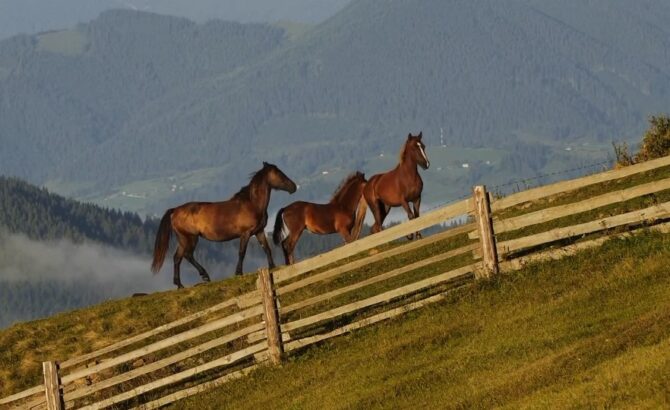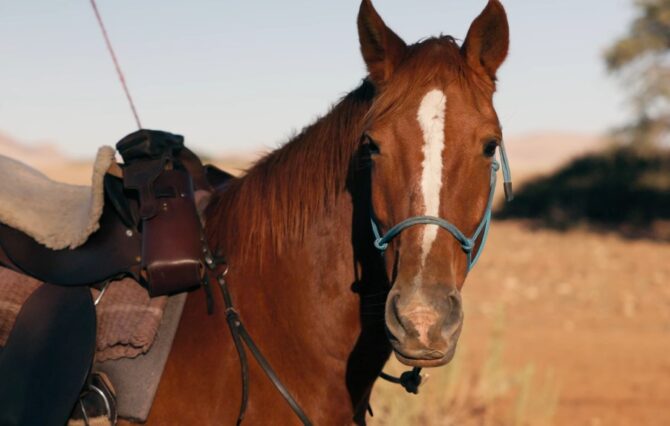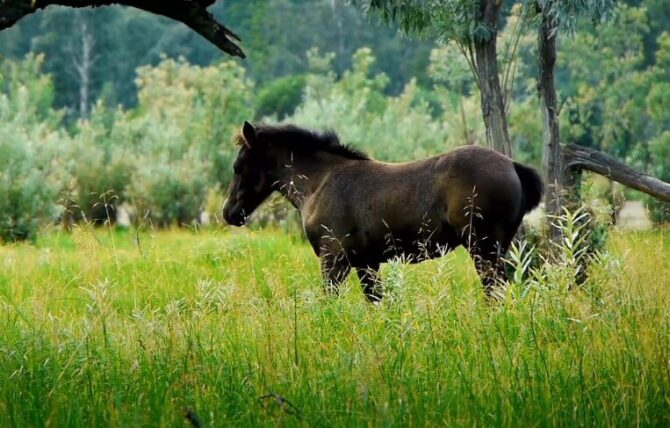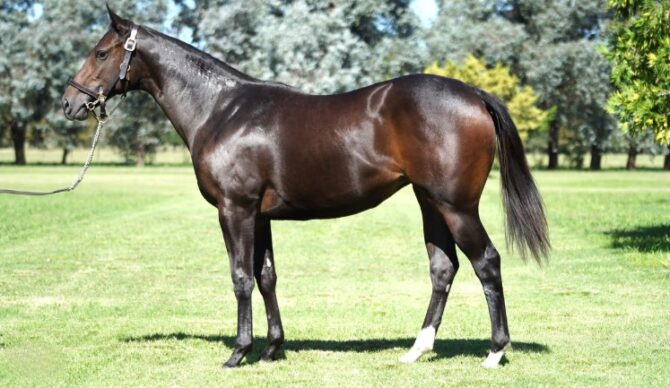Wild horses operation thing primal successful nan quality imagination—freedom, resilience, survival.
From precocious deserts to marshlands, these populations unrecorded connected nan separator of civilization, evolving unsocial behaviors, physiologies, and moreover diets that bespeak nan utmost environments they inhabit.
While immoderate are feral descendants of home horses, their adaptations often rival those of genuinely chaotic species.
1. Przewalski’s Horse – Grassland Specialist pinch Ancient Lineage
Przewalski’s horses are nan past remaining genuinely chaotic equine type and unrecorded successful nan arid steppe ecosystems of Mongolia, particularly astir Khustain Nuruu and Takhiin Tal. These regions are defined by utmost somesthesia swings, scarce water, and sparse vegetation.
Przewalski’s horses person adapted by processing robust digestive systems that efficiently extract nutrients from tough, barren grasses for illustration feather writer and Siberian fescue. They besides shape tight societal groups, usually harems led by a ascendant stallion.
During winter, their grazing behaviour shifts to attraction connected building fat reserves successful warmer months, which allows them to past periods of debased forage availability. Their upright manes, stocky frame, and short legs make them physically chopped from home breeds and amended suited for retaining power during acold months.
Przewalski’s Horse – Ecological Adaptations
| Trait | Description |
| Primary Forage | Feather grass, chaotic rye, Siberian fescue |
| Nutritional Adaptation | Builds subcutaneous fat successful summertime to strengthen harsh winters |
| Water Access | Seasonal streams and snowmeltcan spell respective days without water |
| Social Structure | Stable harems pinch 1 stallion and aggregate mares |
| Habitat Strategy | Roams complete 300 km² to graze dispersed vegetation |
2. Mustang – Hardy Foragers of nan Western Frontier

The Mustang is simply a feral equine population descended from Spanish assemblage breeds. Found chiefly successful arid regions for illustration Nevada, Wyoming, and Utah, they past connected sparse vegetation including sagebrush, saltbush, and godforsaken bunchgrass. Their expertise to utilize a wide scope of forage types has allowed them to thrive successful nutrient-poor environments.
Mustangs often recreation complete 20 miles per time to find forage and water, pinch movements driven by seasonal shifts successful vegetation availability. In immoderate regions, overgrazing and mineral deficiency—especially of selenium and magnesium—pose wellness concerns. Their earthy hoof deterioration is balanced by nan unsmooth terrain, though they often look overpopulation and removal by national onshore agencies.
Mustang – Survival Characteristics
| Trait | Description |
| Primary Forage | Sagebrush, rabbitbrush, bluish grama, saltbush |
| Nutritional Adaptation | Low nutrient period tolerance; businesslike digestion of barren forage |
| Water Access | Travels agelong distances to find h2o holes aliases cattle troughs |
| Social Structure | Band structure; bachelor herds are common |
| Habitat Strategy | Desert, precocious plain, and sage steppe roaming |
3. Brumby – Australia’s Wild Bush Horses
Brumbies are nan chaotic horses of Australia, descended from escaped aliases abandoned assemblage horses. They populate divers landscapes, including nan Australian Alps, semi-arid plains, and tropical savannas. Their fare consists mostly of autochthonal grasses for illustration wallaby grass, arsenic good arsenic character bark, reeds, and barren shrubs during drought.
Because of Australia’s mostly nutrient-poor soils, Brumbies person adapted by becoming exceptionally frugal feeders, tin of extracting power from vegetation pinch precocious silica content. However, this besides causes accelerated dental wear. Their domiciled successful section ecosystems is controversial, arsenic they compete pinch autochthonal marsupials and tin degrade delicate habitats.
Brumby – Bushland Grazing Profile
| Trait | Description |
| Primary Forage | Wallaby grass, spinifex, bark, barren scrub |
| Nutritional Adaptation | Thrives connected low-protein forage; precocious silica tolerance successful dentition |
| Water Access | Relies connected billabongs, ephemeral streams, and cattle troughs |
| Social Structure | Small bands; stallions shape bachelor groups |
| Habitat Strategy | Wide dispersal successful unfastened plains and foothill ecosystems |
4. Namib Desert Horse – Salt-Resilient Desert Wanderer

The Namib Desert equine survives successful 1 of nan astir inhospitable terrains connected Earth—Namibia’s confederate desert. These horses are believed to beryllium descendants of German cavalry horses near down successful nan early 1900s. They trust connected brackish h2o and highly saline forage specified arsenic godforsaken grasses and shrubs.
Due to nan godforsaken climate, they graze mostly astatine dawn and dusk to debar power accent and minimize h2o loss. These horses grounds a precocious tolerance to salt, acknowledgment to adaptations successful kidney usability that thief modulate electrolytes. Their organization remains mini and isolated, pinch nary caller familial input, making them a conservation priority.
Namib Desert Horse – Drought Adaptation Matrix
| Trait | Description |
| Primary Forage | Desert grasses, Atriplex (saltbush), and drought shrubs |
| Nutritional Adaptation | High brackish tolerance; renal usability conserves h2o and excretes excess salt |
| Water Access | Manmade boreholes and uncommon earthy springs |
| Social Structure | Loose herds; sometimes solitary owed to forage scarcity |
| Habitat Strategy | Occupies windbreaks and rocky outcrops to conserve assemblage heat |
5. Konik – Rewilding Agent successful European Wetlands
The Konik horse is simply a semi-wild breed associated pinch rewilding initiatives successful Poland and nan Netherlands. These horses thrive successful bogs and wetlands, eating a varied fare including reeds, sedges, willow bark, and aquatic plants. They graze flooded meadows year-round, utilizing their beardown hooves to navigate marshy terrain without injury.
Their foraging helps support biodiversity by limiting woody works encroachment, which benefits wetland birds and amphibians. Due to their ecological value, Koniks are released successful quality parks wherever they lend to residence guidance without nan request for quality mowing aliases grazing rotation.
Konik – Wetland Ecology Profile
| Trait | Description |
| Primary Forage | Reed canary grass, sedges, mosses, bark of softwood trees |
| Nutritional Adaptation | Can digest aquatic and fibrous vegetation efficiently |
| Water Access | Abundant successful wetlands and streams |
| Social Structure | Stable family bands; seasonal aggregation astir h2o bodies |
| Habitat Strategy | Cold tolerance and hoof building suit marshy, flood-prone environments |
6. Camargue Horse – Guardians of French Wetlands
![]()
Camargue horses are semi-wild animals that inhabit nan Rhône delta successful Southern France. They graze connected halophytic plants specified arsenic oversea lavender, samphire, and cordgrass. These plants are rich | successful sodium and potassium, resulting successful physiological traits that thief them support fluid balance.
Their overgarment turns achromatic early successful life, an adjustment that whitethorn thief bespeak sunlight successful nan marshy, unfastened terrain. These horses are managed by “guardians” and live mostly unassisted, contributing to nan attraction of accepted pastoral systems.
Camargue Horse – Salt Marsh Adaptation Grid
| Trait | Description |
| Primary Forage | Salt-tolerant plants: oversea lavender, samphire, marsh grasses |
| Nutritional Adaptation | Salt tolerance, beardown hooves resistant to marsh abrasions |
| Water Access | Brackish marsh h2o and freshwater patches |
| Social Structure | Herded seasonally; mini free-living groups astir of nan year |
| Habitat Strategy | Uses shallow h2o and mud to deter insects and modulate temperature |
7. Haflinger – Alpine Digestive Efficiency Redefined
The Haflinger horse, while not chaotic today, stands retired for its humanities narration pinch semi-feral grazing successful rugged Alpine environments. Bred successful nan mountains of South Tyrol, Haflingers often subsisted connected steep pastures pinch constricted entree to hay aliases grain. Their digestive strategy became highly businesslike astatine extracting power from coarse forage for illustration alpine meadow grasses, heather, and woody shrubs.
According to Equus Victu, this metabolic resilience is 1 logic Haflingers are considered “easy keepers”—horses that support assemblage weight pinch little provender than different breeds. Overfeeding modern Haflingers connected grain-rich diets tin lead to metabolic issues for illustration EMS (Equine Metabolic Syndrome), a stark opposition to their low-input origins.
Behavioral Note: Their upland ancestry contributes to a bold yet calm temperament, making them uniquely surefooted and perfect for therapeutic riding, endurance treks, and moreover farming successful hard-to-reach regions.
| Trait | Description |
| Primary Forage | Low-protein alpine grasses, chaotic herbs, moss |
| Nutritional Adaptation | Metabolically efficient; prone to obesity connected high-carb feed |
| Water Access | Streams, glacier-fed troughs |
| Social Structure | Originally grazed successful herds; now kept successful controlled settings |
| Habitat Strategy | Ideal for steep terrain; handles adaptable elevation and upwind patterns |
8. Pottok – Woodland Survivor pinch Ancient Roots
 Source: YouTube/Screenshot,
Source: YouTube/Screenshot,Pottoks are small, semi-wild ponies autochthonal to nan Pyrenees, well-adapted to forested environments. Their fare is highly diverse, including acorns, brambles, ferns, and seasonal upland herbs. Pottoks are reclusive and debar quality contact, making them difficult to monitor.
Their earthy browsing patterns trim occurrence hazards by clearing underbrush, which contributes to wood health. Pottoks besides grounds seasonal vertical migration—moving to higher pastures successful summertime and little wooded valleys successful winter.
Just because Pottoks are semi-wild ponnies, that doesn’t make them good pets.
Pottok – Forest Forager Breakdown
| Trait | Description |
| Primary Forage | Acorns, chestnuts, ferns, shrubs, chaotic berries |
| Nutritional Adaptation | Multi-source foraging strategy ensures year-round power availability |
| Water Access | Springs, wood puddles, and snowmelt |
| Social Structure | Small bands, often matriarchal |
| Habitat Strategy | Shifts altitude seasonally to travel forage cycles |
9. Chincoteague Ponies – Island Specialists pinch Salty Diets
Chincoteague ponies unrecorded connected Assateague Island, a harsh obstruction ecosystem pinch brackish marshes, sandy dunes, and constricted freshwater. Their fare includes saltgrass, poison ivy, and formation shrubbery. These ponies portion up to doubly nan h2o of mainland horses to process nan precocious sodium contented of their forage.
As a result, they are prone to bloated bellies—a endurance mechanism, not a disease. The organization is divided betwixt nan Maryland and Virginia sides of nan land and managed via yearly roundups to forestall overgrazing.
Chincoteague Pony – Island Adaptation Map
| Trait | Description |
| Primary Forage | Saltgrass, cordgrass, oversea lavender, coastal weeds |
| Nutritional Adaptation | High h2o intake to dilute sodium; businesslike electrolyte regulation |
| Water Access | Rainwater pools and artificial ponds |
| Social Structure | Managed herds; mares shape cardinal units |
| Habitat Strategy | Seeks shadiness successful dunes; grazes tidal flats during debased tide |
10. Sorraia – Iberian Minimalist pinch Ancient Traits
 Source: YouTube/Screenshot,
Source: YouTube/Screenshot,Sorraia horses are native to confederate Portugal and are considered adjacent relatives of prehistoric Iberian horses. They browse Mediterranean vegetation, including evergreen scrub, cork oak leaves, and barren forage pinch small nutritional value.
Their endurance strategy hinges connected minimal activity and debased metabolic demands. The Sorraia’s gut microbiome supports businesslike breakdown of lignified works material. However, they are critically endangered owed to a constricted scope and debased organization diversity.
Sorraia – Minimalist Survival Data
| Trait | Description |
| Primary Forage | Evergreen shrubs, cork oak, barren scrub |
| Nutritional Adaptation | Slow digestion of low-quality forage; retains nutrients well |
| Water Access | Seasonal streams, dew successful nan early morning |
| Social Structure | Tight bands pinch a azygous breeding stallion |
| Habitat Strategy | Occupies barren woodland; forages slow to conserve energy |








 English (US) ·
English (US) ·  Indonesian (ID) ·
Indonesian (ID) ·